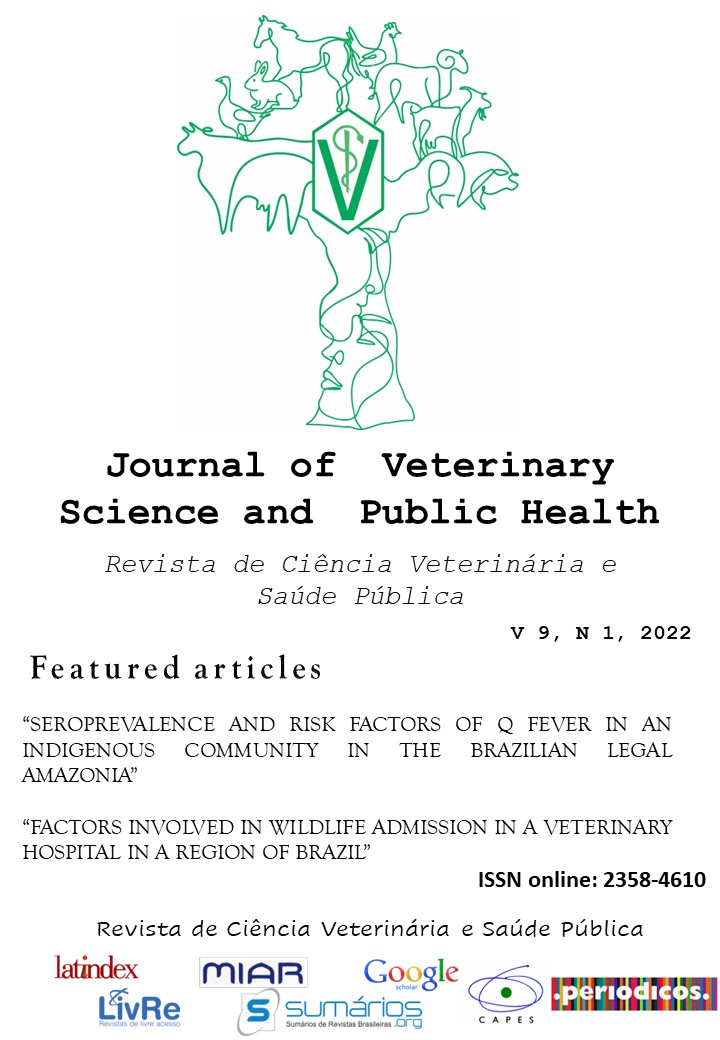OCORRÊNCIA DE COCCÍDIOS INTESTINAIS EM MATRIZES E LEITÕES EM UMA MATERNIDADE SUÍNA
Abstract
Gastrointestinal disorders in pigs are one of the biggest problems faced by modern pig farmers. Intensive production together with the misuse of antiparasitic agents and the incorrect cleaning and disinfection of facilities favor the infection of animals. Several pathogens can be responsible for causing gastrointestinal disorders in pigs, with coccidia in particular being responsible for the development of diarrhea in piglets, which directly compromises their development and generates additional costs to the production chain. However, not much research on the prevalence of these parasites in intensive piggeries has been carried out. Therefore, in this study, we aimed to evaluate the occurrence of intestinal parasites in sows and piglets in an intensive pig farm in the municipality of Palotina in Paraná, Brazil. In total, 94 stool samples (41 sow and 53 litter samples) were collected in three maternity rooms and analyzed using the coproparasitological techniques of Willis-Mollay and Sheather. Of all the samples analyzed, 10.64% were positive for at least one coccidium (10/94), with 2.13% (2/94) identified as Cystoisospora suis, 1.06% identified as oocysts of Giardia spp. (1/94), and the remainder (7/94) not identifiable. The results allowed us to verify that intestinal parasites were still present in the maternity facilities of intensive piggeries, even with the adoption of supposedly effective antiparasitic protocols. Therefore, constant surveillance of the effectiveness of the antiparasitic treatments applied to the animals must be carried out to avoid unnecessary expenses brought about by inefficient animal handling.
Downloads
References
BLV, Projekt PathoPig. 2016 https://www.blv.admin.ch/blv/de/home/tiere/
tiergesundheit/frueherkennung/pathopig.html.
COELHO, Wesley A. C. Anthelmintic resistance in goats in Mossoró-RN. 2009. 57 f. Dissertação (Mestrado em Sanidade e Produção Animal) - Universidade Federal Rural do Semi-Árido, Mossoró.
d’ALENCAR, A.S.; FAUSTINO, M.A.G.; SOUSA, D.P.; de LIMA, M.M; ALVES, L.C. Infecção por helmintos e coccídios em criação de suínos de sistema confinado localizada no município de Camaragibe-PE. Ciência Veterinária nos Trópicos, v.9, p.79-86, 2006.
HELLARD, M.E.; SINCLAIR, M.I.; HOGG, G.G.; FAIRLEY, C.K. Prevalence of enteric pathogens among community based asymptomatic individuals. Journal of Gastroenterology and Hepatology, v.15, p.290–293, 2000.
Instituto Água e Terra (IAT). Plano de Manejo - Parque Estadual de São Camilo - Análise da Região da Unidade de Conservação [Online]. 2006 [citado 2020 Nov 01]. Available from: http://www.iat.pr.gov.br/Pagina/Plano-de-Manejo-Parque-Estadual-de-Sao-Camilo#
LINDSAY, D.S.; CURRENTM W.L.; TAYLOR, J.R. Effects of experimentally
induced Isospora suis infection on morbidity, mortality, and weight gains in nursing pigs. American Journal of Veterinary Research, v.46, p.1511–1512, 1985.
LINHARES, G.F.C.; SOBESTIANSKY, J.; LINHARES, D.; BARCELLOS, D.;
MORENO, A.M.; MATOS, M.P.C. Endoparasitoses. In: SOBESTIANSKY, J; BARCELLOS, D. Doenças dos Suínos. 2.ed. Goiânia: Cânone Editorial, 2012. Cap.6, p.433-466.
LIU, H.; XU, N.; YIN, J.; YUAN, Z.; SHEN, Y.; CAO, J. Prevalence and multilocus genotyping of potentially zoonotic Giardia duodenalis in pigs in Shangai, China. Parasitology, v.146, p.1199-1205, 2019.
MELO, A.C.F.L.; BEVILAQUA, C.M.L.; SELAIVE, A.V.; GIRÃO, M.D. Resistência a anti-helmínticos em nematódeos gastrintestinais de ovinos e caprinos, no município de Pentecoste, Estado do Ceará. Ciência Animal, v.8, p.7-11, 1998.
MELO, Ana C.F.L. Resistência a anti-helmínticos em nematódeos gastrintestinais de ovinos e caprinos na região do baixo e médio Jaguaribe. 54f. 2001. Dissertação (Mestrado em Ciências Veterinárias) – Departamento de Ciências Animais, Universidade Estadual do Ceará, Fortaleza.
MEYER, C.; JOACHIM, A.; DAUGSCHIES, A. Occurrence of Isospora suis in larger piglet production units and on specialized piglet rearing farms. Veterinary Parasitology, v.82, p.277–284, 1999.
MOLENTO, M. B. Resistência de helmintos em ovinos e caprinos. Revista Brasileira de Parasitologia Veterinária, v. 13, p.82-85, 2004.
NISHI, S.M.; GENNARI, S.M.; LISBOA, M.N.T.S.; SILVESTRIM, A.; CAPROANI Jr, L.; UMEHARA, O. Parasitas Intestinais em Suínos Confinados nos Estados de São Paulo e Minas Gerais. Arquivos do Instituto Biológico, v.67, p.199-203, 2000.
SCHUBNELL, F.; VON AH, S.; GRAAGE, R.; SYDLER, T.; SIDLER, X.; HADORN, D.; BASSO, W. Occurrence, clinical involvement and zoonotic potential of endoparasites infecting Swiss pigs. Parasitology International, v.65, p.618-624, 2016.
SHEATHER, A.L. The detection of intestinal protozoa and mange parasites by a floatation technique. Journal of Comparative Pathology and Therapeutics, v.36, p.266-275, 1923.
SOBESTIANSKY, J.; WENTZ, I.; SILVEIRA, P.R.S.; SESTI, L.A.C. Suinocultura intensiva: produção, manejo e saúde do rebanho. 1.ed. Brasília: EMBRAPA-SPI, 1988. 388p.
SOTIRAKI, S.; ROEPSTORFF, A.; NIELSEN, J.P.; MADDOX-HYTTEL, C.; ENOE C.; BOES, J.; MURRELL, K.D.; THAMSBORG, S.M. Population dynamics and intra-litter transmission patterns of Isospora suis in suckling under on-farm conditions. Parasitology, v.135, p.395-405, 2008.
THOMPSON, R.C. Giardiasis as a re-emerging infectious disease and its zoonotic potential. International Journal for Parasitology, v.30, p.1259–1267, 2000.
WILLIS, H.H. A simple levitation method for the detection of hookworm ova. Medical Journal of Austrália, v.8, p.375-376, 1921.
ZIMMERMAN, J.F.; KARRIKER, L.A.; RAMIREZ, A.; SCHWARTZ, K.J.; STEVENSON, G.W. Diseases of Swine. 10.ed. West Sussex: Wiley-Blackwell, 2012. 1012p.








